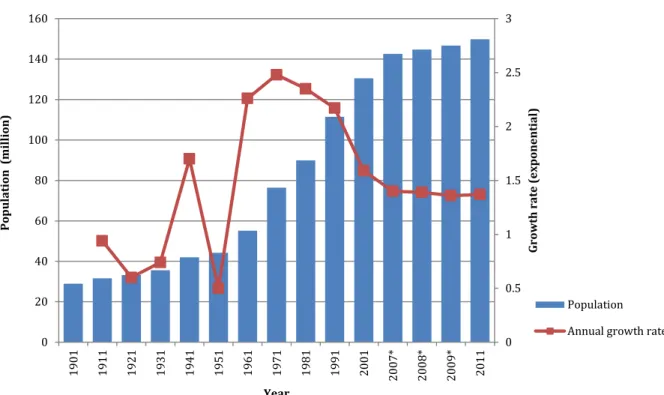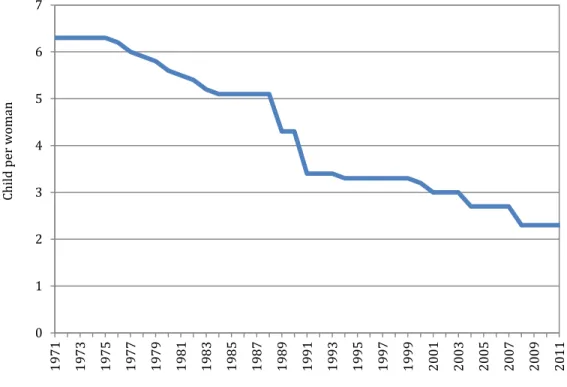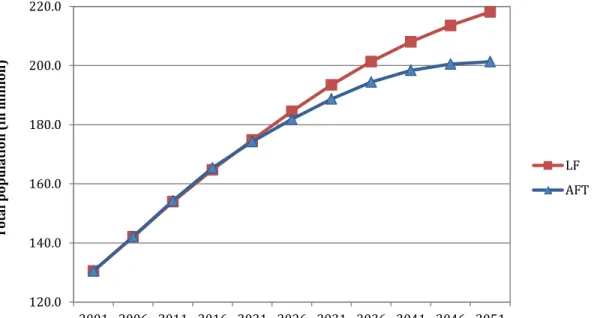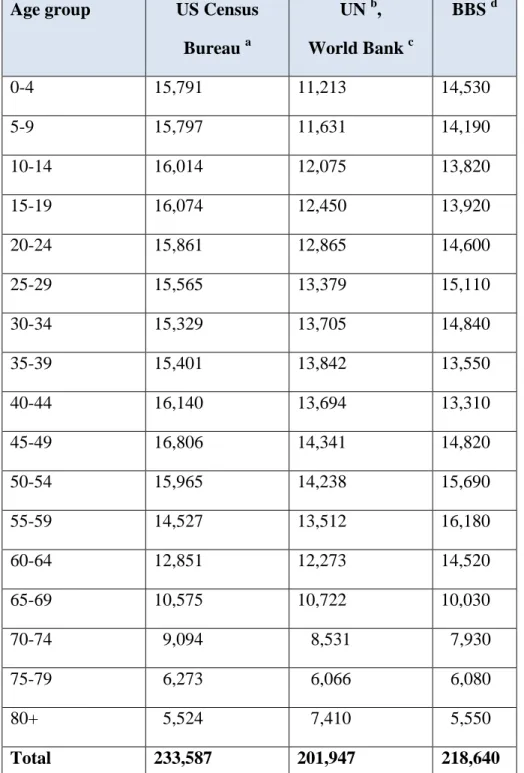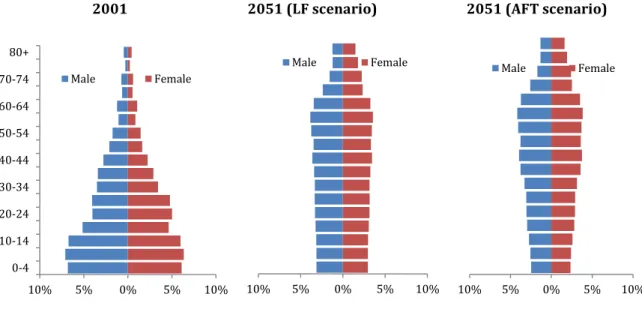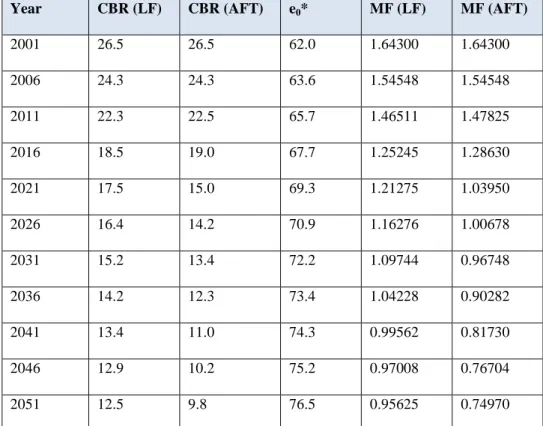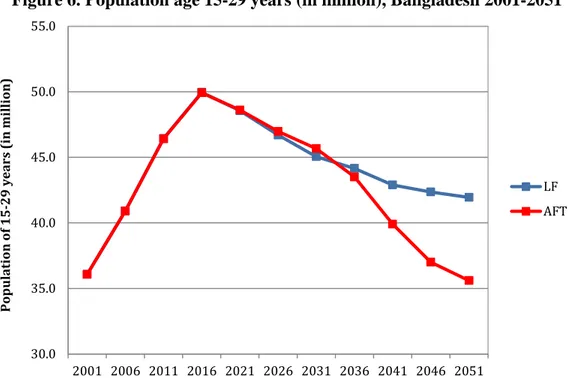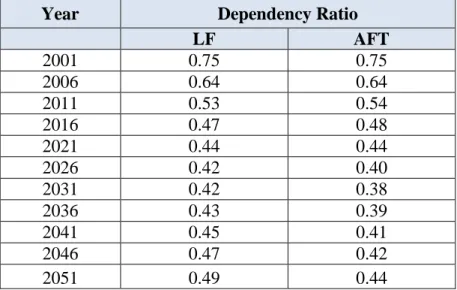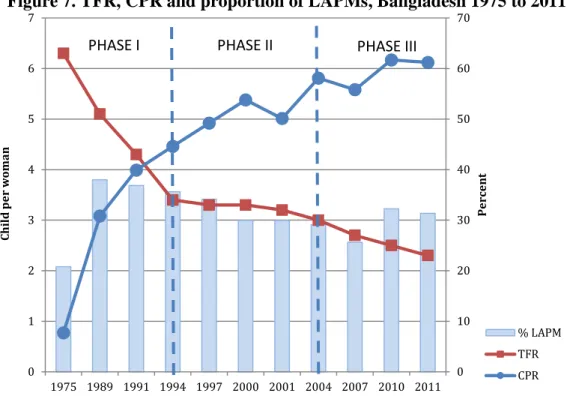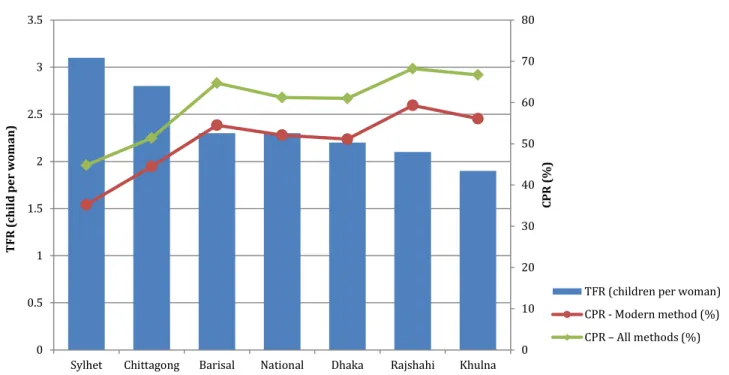POPULATION, FAMILY PLANNING AND REPRODUCTIVE HEALTH POLICY
HARMONIZATION IN BANGLADESH
D I S C U S S I O N P A P E R N O V E M B E R 2 0 1 4
Sameh El-Saharty Karar Zunaid-Ahsan John F. May
Public Disclosure AuthorizedPublic Disclosure AuthorizedPublic Disclosure Authorized
92650
Population, Family Planning, and Reproductive Health Policy Harmonization in Bangladesh
Sameh El-Saharty Karar Zunaid Ahsan
John F. May
Health, Nutrition and Population (HNP) Discussion Paper
This series is produced by the Health, Nutrition, and Population (HNP) Global Practice of the World Bank. The papers in this series aim to provide a vehicle for publishing preliminary results on HNP topics to encourage discussion and debate. The findings, interpretations, and conclusions expressed in this paper are entirely those of the author(s) and should not be attributed in any manner to the World Bank, to its affiliated organizations or to members of its Board of Executive Directors or the countries they represent. Citation and the use of material presented in this series should take into account this provisional character.
For information regarding the HNP Discussion Paper Series, please contact Martin Lutalo at mlutalo@worldbank.orgor Erika Yanick at Eyanick@worldbank.org.
© 2014 The International Bank for Reconstruction and Development / The World Bank 1818 H Street, NW Washington, DC 20433
All rights reserved
Health, Nutrition and Population (HNP) Discussion Paper
Population, Family Planning, and Reproductive Health Policy Harmonization in Bangladesh
Sameh El-Sahartya Karar Zunaid Ahsanb John F. Mayc
a Health, Nutrition and Population Global Practice, World Bank, Washington DC, USA
b MEASURE Evaluation, University of North Carolina at Chapel Hill, NC, USA
c Visiting Scholar, Population Reference Bureau, Washington DC, USA
This paper was funded by the Bank-Netherlands Partnership Program for Sexual and Reproductive Health in South Asia
Abstract: Over the past 30 years, Bangladesh has achieved significant economic and human development progress, and demonstrated impressive policy as well as programmatic commitment to lowering the fertility level. However, its future socioeconomic prospects may be hampered by its population growth rate, depending on how quickly the fertility rates decline and at which point they stabilize.
Projections estimate that the total population of Bangladesh in 2051 could increase to 218.1 million under a laissez faire projection scenario and 201.3 million under an accelerated fertility transition (AFT) scenario. This difference would have significant impacts on public spending, public services, and job creation. An AFT scenario would enable the country to improve the dependency ratios – possibly resulting in economic benefits from harnessing the demographic dividend for several decades.
To accelerate the demographic transition, the government will need to revitalize high-level coordination to ensure multisectoral engagement in population policies, including increasing the age at marriage, and improving education, skills development, job creation, and social safety nets for the vulnerable population groups. In addition, a sustained decline in fertility through increased access and coverage of family planning (FP) services is crucial, mainly by focusing on lagging regions and hard-to-reach areas, and by expanding the supply and provision of FP long acting and permanent methods. Strengthening the synergy and coordination of service delivery between the Health and FP directorates by building capacity for systems strengthening;
promoting cross-referral between programs; and efficient provisioning of FP and reproductive health services through community clinics need to remain at the forefront of the government’s health improvement efforts in Bangladesh.
Keywords: Population projection; family planning; reproductive health policy; health policy;
Bangladesh.
Correspondence Details: Sameh El-Saharty, World Bank, 1818 H St. NW, Washington DC, USA, tel: 202-458-7014, fax: 202-522-3408, email: selsaharty@worldbank.org, website:
www.worldbank.org/hnp
Table of Contents
ACKNOWLEDGMENTS ... vi
LIST OF ACRONYMS ... vii
EXECUTIVE SUMMARY ... ix
1. INTRODUCTION... 1
2. DEMOGRAPHIC PROJECTIONS AND CHALLENGES ... 4
3. FERTILITY AND FAMILY PLANNING ... 13
4. REPRODUCTIVE HEALTH SERVICES ... 19
5. PROGRAM IMPLEMENTATION CHALLENGES ... 22
6. TOWARDS POLICY HARMONIZATION ... 25
GLOSSARY... 29
ANNEX 1: OLD AND NEW POPULATION PROJECTIONS ... 31
ANNEX 2: PROXIMATE DETERMINANTS OF FERTILITY ... 35
ANNEX 3: EARLY MARRIAGE AND FIRST BIRTH ... 37
REFERENCES ... 39
TABLES Table 1. Projected Population by 5-year Age-groups, Both Sexes, Bangladesh 2050 (thousands) ... 7
Table 2. Crude Birth Rates (CBR) and Momentum Factors (MF), Bangladesh 2001-2051 ... 9
Table 3. Dependency Ratios, Bangladesh 2001-2051 (LF and AFT scenarios) ... 11
Table 4. Bangladesh Health Facility Survey (BHFS) Estimates on Availability of FP Supplies in Health Facilities, 2009 and 2011 ... 22
FIGURES Figure 1. Numbers and Annual Growth Rate of Population, Bangladesh 1901-2011 ... 4
Figure 2. Trend in Total Fertility Rate, Bangladesh 1971-2011 ... 5
Figure 3. Projected Population of Bangladesh, LF and AFT scenarios, 2001-2051 ... 6
Figure 4. Current and Projected Population Pyramids (LF and AFT), Bangladesh 2001-2051 ... 8
Figure 5. Age Structure of Baseline and Projected Population, Bangladesh 2001-2051 ... 8
Figure 6. Population age 15-29 years, Bangladesh 2001-2051 ... 10
Figure 7. TFR, CPR and proportion of LAPMs, Bangladesh 1975 to 2011 ... 14
Figure 8. Geographic Distribution of TFR and CPR, Bangladesh 2011 ... 15
Figure 9. Geographic Distribution of TFR and CPR, Bangladesh 2011 ... 15
Figure 10. CPR Method Mix, Bangladesh 1993-2013 ... 16
ACKNOWLEDGMENTS
The paper was prepared by a core team consisting of Sameh El-Saharty, Senior Health Policy Specialist and Team Leader, South Asia Region, the World Bank, Washington, DC, United States; Karar Zunaid Ahsan, Senior Research Associate, MEASURE Evaluation, University of North Carolina at Chapel Hill, NC, United States; and John F. May, Visiting Scholar, Population Reference Bureau, Washington, DC, United States (consultant).
The team would like to thank the officials of the Ministry of Health and Family Welfare, Government of Bangladesh, for reviewing the paper and providing useful comments and feedback.
The team is grateful to the peer reviewers of the paper for their constructive comments. The peer reviewer from Bangladesh was Sadia Afroze Chowdhury, Executive Director, James P. Grant School of Public Health, BRAC University. The peer reviewers from the World Bank were Albertus Voetberg, Lead Health Specialist/Acting Practice Manager, South Asia Region, Health Nutrition and Population Global Practice and Rafael Cortez, Senior Economist (Health), Health Nutrition and Population Global Practice.
The team would like to thank several World Bank colleagues who provided comments on different drafts of the paper including Bushra Binte Alam, Senior Health Specialist, Iffat Mahmud, Operations Officer, Jean-Jacques Frère, Health Adviser (consultant), and Federica Secci, Health Specialist, South Asia Region, Health Nutrition and Population Global Practice.
Special thanks go to Nasreen Begum and Shahadat Chowdhury, for their logistical support.
Assistance in editing the paper was provided by Jonathan Aspin (consultant).
Finally, the core team would like to extend its gratitude to Julie McLaughlin, Adviser, Global Practice Cross-Cutting Solutions, the World Bank for her guidance and support during the preparation of the study and the dissemination of the final paper.
The authors are grateful to the World Bank for publishing this report as an HNP Discussion Paper.
LIST OF ACRONYMS
AFT Accelerated Fertility Transition
AIDS Acquired Immune Deficiency Syndrome ANC Antenatal care
BBS Bangladesh Bureau of Statistics
BDHS Bangladesh Demographic and Health Survey BRAC Bangladesh Rural Advancement Committee CBR Crude Birth Rate
CC Community Clinic
CPR Contraceptive Prevalence Rate
DGFP Directorate General of Family Planning DGHS Directorate General of Health Services DHS Demographic and Health Survey EPI Expanded Program of Immunization FP Family Planning
FPAB Family Planning Association of Bangladesh FWA Family Welfare Assistant
HFWC Health and Family Welfare Center HNP Health, Nutrition, and Population
HNPSP Health, Nutrition, and Population Sector Program
HPNSDP Health, Population, and Nutrition Sector Development Program HPSP Health and Population Sector Program
IBAS Integrated Budget and Accounting System
ICDDR,B International Centre for Diarrheal Disease Research, Bangladesh ICPD International Conference on Population and Development IDA International Development Association
IEC Information, Education, and Communication
IIASA International Institute for Applied Systems Analysis IMR Infant Mortality Rate
IUD Intrauterine Devices
JICA Japan International Cooperation Agency
LAPM Long-acting and permanent contraceptive method LF Laissez-faire
LMIS Logistics Management Information System MCH Maternal and Child Health
MOHFW Ministry of Health and Family Welfare MR Menstrual Regulation
NCD Non-communicable Disease NGO Non-Governmental Organization
PNC Postnatal care
PROMIS Procurement Management Information System RD Rural Dispensary
RH Reproductive Health SBA Skilled Birth Attendance SMC Social Marketing Company STD Sexually Transmitted Disease SWAp Sector Wide Approach
TFR Total Fertility Rate
UESD Utilization of Essential Service Delivery UN United Nations
USAID United States Agency for International Development
EXECUTIVE SUMMARY
The aim of this Policy Note is to analyze the population trends and impact and assess the family planning and reproductive health programs in order to provide options for policy harmonization across the three areas. Specifically, the Policy Note examines the demographic challenges and population projections as well as the fertility and family planning trends, describes the family planning and reproductive health programs, and assesses the institutional and implementation challenges facing these programs.
In recent years, Bangladesh has achieved significant economic gains. The last three-year trend in gross domestic product has showed economic growth above 6 percent a year, which is comparable to some of the best-performing economies in Asia. Bangladesh has also made remarkable progress in many areas of human development. Human development indicators trending upwards include increased life expectancy and levels of literacy, sustained child immunization rates above 80 percent, and a sharp decline in the maternal mortality ratio.
Bangladesh has experienced profound demographic transformations as well, most notably a remarkable decline of its high levels of fertility. Nonetheless, the country’s socioeconomic prospects are still hampered by rapid population growth, severe soil degradation (which is linked to climate change), and uncontrolled urbanization including the proliferation of slum areas.
Moreover, 32 percent of the Bangladeshi population still lives below the poverty line and about 40 percent are underemployed. These challenges are poised to jeopardize ongoing efforts to foster economic growth and ensure full employment, which are both needed to reduce poverty levels.
The population of Bangladesh has quadrupled in the last hundred years. Such a large increase in Bangladesh’s population, especially during the second half of the 20th century, was mainly due to a sharp mortality decline, which was made possible by major improvements in medical technology and vigorous public health measures. The 2011 Population & Housing census estimated the population at 149.8 million. This gives an annual population growth rate of 1.37 percent and a population density of 1,015 people per square kilometer. The population will continue to grow due to the phenomenon of population momentum, which is linked to the youthfulness of the demographic age structure.
Population momentum will be partially offset by the pace of continued fertility decline—
especially if fertility decreases for a period of time below the replacement level of about 2.1 children per woman (i.e., the level enabling the replacement of generations). Therefore, accelerating the fertility decline appears to be a crucial step for Bangladesh to stabilize its growing population. A more rapid fertility decline has the potential to reduce population growth in absolute numbers by one-twelfth by the middle of the 21st century. The ultimate stabilization of the population will depend on how these two factors (i.e., population momentum and continued fertility decline) play out, but by 2050 it is expected that about 50 million more people
Bangladesh population projections point also to the less-often discussed dimension of population aging. The impending significant expansion of the elderly group, estimated to constitute nearly one-sixth of the total population by mid-century, will have major implications for health and social security in the medium and long-term, especially as current elderly care services are not yet adequate. It is expected that health expenditures in Bangladesh will increase by 48 percent by 2020 due to population growth and population aging.
Fertility plays a key role in determining Bangladesh’s future demographic outcomes. A sustained fertility decline through increased family planning coverage will be essential to accelerate the demographic transition. A faster fertility decline would enable the country to better address its youth bulge and improve its dependency ratio, which could help Bangladesh to reap the potential benefits of a demographic dividend. This would lead also to less pressure on public finance for infrastructure and services as well as enable the country to foster job creation through adequate educational and social policies conducive to increased employability.
However, Bangladesh will not only have to bring down fertility levels to about half-a-child below replacement level, but also to keep them there for 30 years in order to stabilize the country’s overall population at around 200 million.
Fertility decline is strongly linked to effective family planning services. Between 1975 and 2011, the total fertility rate (TFR) declined from 6.3 to 2.3 children per woman, while the contraceptive prevalence rate (CPR) increased from 7.7 percent to 61.2 percent (all methods).
The family planning method mix has evolved over the past decade and a half. Coverage of modern family planning methods increased by almost 20 percentage points from 1993 to 2010, when the use of the pill almost doubled and the use of injectable contraceptives almost tripled.
However, the use of other modern family planning methods, such as condoms and NORPLANT® raised more slowly or even fell as in the case of intrauterine devices and female and male sterilization. The use of traditional contraceptive methods also declined. The public sector remains the main provider of family planning services, although the private sector provision has increased over the years.
Despite its past successes, Bangladesh’s family planning program faces several challenges. The current program’s contraceptive method mix is still dominated by short-term methods, whereas long-term/clinical methods are needed to accelerate and complete the fertility transition.
Moreover, the age at first birth has not changed much: a quarter of all teenage girls have at least one child. The usual pattern for couples in Bangladesh is early marriage, rapid childbearing, and then reliance on short-term (less effective) contraceptive methods to avoid subsequent pregnancies.
In addition, the TFRs and the CPRs show wide regional variations. The Western part of the country has already attained replacement-level fertility, as illustrated by the Rajshahi and Khulna divisions. In these divisions, five districts already experience below-replacement fertility levels:
1.8 to 2.0 children per woman. However, fertility levels in the Eastern part of the country are still one child on average above replacement-level. Unmet family planning need remains high at 13.5 percent of Bangladeshi women. Low-performing family planning divisions like Sylhet and Chittagong in the East have the highest unmet needs, while the high-performing divisions like Rajshahi and Khulna in the West have unmet need of about 10 percent each.
Similarly, there was great progress in the provision of Reproductive Health (RH) services, particularly those aimed at reducing maternal mortality, which has declined by almost 40 percent in the decade from 2000 to 2010. However, more focused efforts are needed to provide antenatal care to about half of the pregnant women not receiving it and increase access to skilled birth attendants to two third of pregnant women who are accessing these services as well as addressing the wide regional and socioeconomic disparities.
In addition, the FP and RH programs are faced with implementation and institutional challenges.
Contraceptive suboptimal availability is a major bottleneck, which have led to high contraceptive discontinuation thus leading to unplanned pregnancies. Also, contraceptives are mostly funded by donors and the government needs to have a plan to secure their financing in the long-term.
The fragmentation of FP and RH services across seven Operational Plans makes weakens the coordination between the two programs, which is further exacerbated by the acute shortage of human resources for health.
What needs to be done?
The government will need to improve coordination and strengthen the policies and programs related to population, FP and RH services.
The 2004 Bangladesh Population Policy was also updated with revised goals and implementation plans in order to attain replacement levels of fertility by 2015. This new policy was endorsed by the Cabinet in September 2012. Going forward, the MOHFW, through the National Population Council, should help to revitalize and strengthen high-level governmental coordination to ensure broad socio-economic policies and multi-sectoral engagement on population policies and programs. To accelerate the demographic transition, harness the economic benefits of the youth bulge, and capture a demographic dividend, the government must also pursue policies to expand education, particularly for women, increase the age at marriage and first birth, and invest in skills development for the unemployed and job creation for the new entrants to the job market, coupled with expanding the safety nets for the elderly and vulnerable populations. This would require stronger coordination within the public sector and between the public and private sectors. In particular, increasing the age at marriage is an important policy lever that could significantly reduce fertility levels.
A key driver of fertility decline is increased use of FP services. The MOHFW should improve access to, and coverage of, FP services through the following actions:
• Shift the FP program strategically and expand the supply of long-acting and permanent contraceptive methods, which are more reliable and less expensive.
• Adopt a strategy to address the contraception unmet need, which would rapidly reduce fertility levels.
• Conduct ongoing stakeholder consultations to ensure contraceptive security and program financial sustainability.
• Strengthen the institutional and technical capacity of the DGFP to manage the procurement of FP commodities more effectively.
• Strengthen the “social marketing” program as it played a critical role in increasing access to contraceptives.
• The FP program should engage community leaders to influence behavior change at the local level.
The MOHFW will need to improve the synergy and coordination of service delivery between the DGHS and the DGFP through the following actions:
• Increase linkages of RH services, e.g., antenatal and postnatal care and institutional deliveries, to FP services, through cross-referral between programs, for example;
• Use efficient provisioning and integrated approach of FP and RH services at the level of Community Clinics as the first point of service delivery; and
• Address the acute shortage of health workers by increasing the use of trained community health workers to generate demand for FP and RH services, particularly in lagging regions.
• Harmonize the FP and RH indicators across the different OPs and strengthen the MOHFW’s capacity to triangulate data collected from various household surveys and use the data more optimally for decision making.
• Integrate screening, prevention and low cost treatment of NCDs at the primary care level to address the health needs of the aging population in order to avoid future cost escalation.
In conclusion, harmonization between population policies and FP and RH programs will be necessary to accelerate the fertility transition and improve maternal and reproductive health outcomes in Bangladesh. It is the convergence of policies and programs that will enable Bangladesh to tackle its demographic, health and poverty reduction challenges and contribute to its economic growth.
1. INTRODUCTION
Over the past decade, Bangladesh has registered impressive progress in the economic sector. The gross domestic product, gross national income, and per capita income have risen markedly (World Bank 2013a). The three-year trend in gross domestic product has showed economic growth above 6 percent a year, on par with some of the best-performing economies in Asia. The per capita gross domestic product was estimated at US$838 and the per capita gross national income at US$923 in 2012-2013 (Government of Bangladesh 2013). Yet 32 percent of the Bangladeshi population still live below the poverty line and about 40 percent are underemployed (BBS 2010, 2012).
During this period, Bangladesh has made also remarkable progress in many human development areas. These include increasing life expectancy at birth as well as levels of literacy, sustaining child immunization above 80 percent, triggering a decline in infant and child mortality rates, and achieving a significant decline of the maternal mortality ratio (MMR). On health services delivery, antenatal care visits for pregnant women by medically trained providers increased from 33 percent in 1999-2000 to 55 percent in 2011, and delivery by medically trained providers from 12 to 32 percent over the same period (NIPORT et al. 2013: 122-123 & 130).
This increase in skilled attendance delivery stemmed predominantly from a rise in facility deliveries, which rose from 8 to 29 percent over the same period (NIPORT et al. 2013: 128).
The increase in skilled attendance delivery, coupled with reduced fertility, led to a 40 percent reduction in MMR from 322 per 100,000 live births in 2001 to 194 in 2010 (NIPORT et al. 2012:
xx, Arifeen et al. 2014). Gradual improvement of basic health and nutrition services also generated a sharp fall in under-five mortality (from 94 deaths per 1,000 live births in 1999-2000 to 53 in 2011) (NIPORT et al. 2013: 114)—an achievement for which Bangladesh received the United Nations Millennium Development Goals Award in 2010.
In addition, Bangladesh has made great progress in accelerating its demographic transition through an impressive decline in fertility. The pivotal decades in this endeavor were the 1970s and 1980s. The fertility decline stalled between 1993 and 2002, but has since resumed.
The 2011 Population and Housing Census estimated the Bangladesh population to be 149.8 million. Today, the total fertility rate (the average number of children per woman) is about 2.3 children per women on average, and 61.2 percent of couples use a contraceptive method (52.1 percent use a modern method) (NIPORT et al. 2013: 85).
The country also adopted a broader reproductive health agenda, which was agreed to at the International Conference on Population and Development (ICPD) in Cairo in September 1994. With support of development partners including the World Bank, Bangladesh has also implemented an ambitious health sector reform program, which should help enhance efforts in the area of family planning and reproductive health.
Population momentum1 (due to the young age structure) points to continued rapid growth of the population. However, the population momentum will be partially offset by the pace of continued fertility decline—especially if fertility decreases for a period of time below the replacement level of about 2.1 children per woman (i.e., the level enabling the replacement of generations). The decline in fertility will hinge on the successful implementation of family planning and reproductive health programs, which will be enhanced by the health sector reform efforts. The ultimate stabilization of the population will depend on how these two factors (i.e., population momentum and continued fertility decline) play out, but by 2050 it is expected that about 50 million more people will be added to the population of Bangladesh. Finally, the capital Dhaka is one of the fastest-growing cities in Asia, and the country’s other urban centers are also growing fast. Rapid urbanization and possible expansion of slum populations are therefore also set to become major issues.
Despite its initial successes, Bangladesh’s family planning program faces several challenges.
The current program’s contraceptive method mix is dominated by short-term methods, whereas long-term/clinical methods will be needed to accelerate and complete the fertility transition.
Moreover, age at marriage and first birth has not changed much: a quarter of the country’s teenage girls (15-19) have at least one child (NIPORT et al. 2013: 72). The usual pattern for couples is early marriage, rapid childbearing, and then reliance on short-term (less effective) contraceptive methods to avoid subsequent pregnancies. As a result, post-abortion conditions appear to be an important issue, according to anecdotal information. Moreover, family planning activities and health services more broadly are not as well coordinated operationally as they should be.
In recent years, population, family planning, and reproductive health issues have received less attention and this has not been conducive to decisive actions in this area. Moreover, the Bangladesh 2004 National Population Policy (Government of Bangladesh 2004), which did not include any costing figures, had not been implemented effectively. The National Population Council (NPC), headed by the Prime Minister, has rarely met and lack of clarity surrounds its mandate and role (the NPC last meeting was in September 2010, whereas it had convened almost every month during the period 1982 to 1990). It is also unclear which public body is in charge of implementing the population policy—in particular, the roles of the Directorates under the Ministry of Health and Family Welfare (MOHFW) are not well defined. The government has revised and updated the Bangladesh 2004 National Population Policy (a draft was prepared in 2009 and adopted by the Cabinet in September 2012). Although the new policy pays more attention to institutional arrangements and costing of activities, there is still a need to rekindle the efforts needed to accelerate the demographic transition through greater use of family planning services with the ultimate aim of stabilizing the population. Addressing the uncertainties regarding the National Population Council and resuscitating the MOHFW’s role as the
1 This is characterized by the tendency for a population to continue to grow even after achieving replacement-level fertility rates due to a past high total fertility rate, which results in a relatively high concentration of young people in childbearing ages (see Glossary).
Secretariat of the NPC will address a major bottleneck to the implementation of National Population Policy in Bangladesh.
The aim of this Policy Note is to analyze the population trends and review the FP and RH programs to provide options for policy harmonization. Specifically, the Policy Note will examine the demographic challenges and population projections of Bangladesh as well as the fertility and family planning trends. The Note will present two scenarios of population projections until 2050 (a laissez-faire and an accelerated fertility transition), and discuss the changes in the age structure and dependency ratios (young and elderly) brought about by various paces of fertility decline. It will explain also why fertility and family planning are important for future population growth, analyze the proximate determinants of fertility (using the Bongaarts model), and examine cultural factors behind early marriage and first birth as well as high fertility outcomes. It will then look at the health sector to examine the family planning and reproductive health programs, analyzing their trends and barriers to the use of their services. The Note will also identify some of the key implementation and institutional challenges facing these programs.
Finally, it will provide options for policy harmonization across the population, family planning and reproductive health programs in order to achieve better economic and social outcomes.
0 0.5 1 1.5 2 2.5 3
0 20 40 60 80 100 120 140 160
1901 1911 1921 1931 1941 1951 1961 1971 1981 1991 2001 2007* 2008* 2009* 2011 Growth rate (exponential)
Population (million)
Year
Population Annual growth rate
2. DEMOGRAPHIC PROJECTIONS AND CHALLENGES
This section focuses on the demographic challenges facing Bangladesh through mid-century and uses two major population projection scenarios, namely a laissez-faire (LF) scenario and an accelerated fertility transition (AFT) scenario. Accordingly, the section discusses the changes in the country’s demographic patterns and trends, reviewing the issues of population growth, age structure, population momentum, youth bulge, and dependency ratios. The section also assesses the chances of Bangladesh of capturing the demographic dividend.
The population of Bangladesh, which was estimated in 2011 at 149.8 million people, has quadrupled in the last hundred years. Population censuses began in 1872, and the most recent census was conducted in 2011. The string of censuses show that the population increased from 29 million in 1901 to 129 million in 2001 and reached nearly 150 million in 2011 (Figure 1).
After 1950, Bangladesh’s population growth rate increased very sharply and reached a peak in the 1970s. Population annual growth began to decelerate in the 1990s and has stayed since 2006 at slightly under 1.4 percent a year. The population density is estimated at 1,015 people per square kilometer.
Figure 1. Numbers and Annual Growth Rate of Population, Bangladesh 1901-2011
*Estimated from the Sample Vital Registration System; all other figures are taken from censuses.
Sources: BBS - Bangladesh Bureau of Statistics (2009). Statistical Yearbook 2009. Dhaka: Ministry of Planning;
BBS - Bangladesh Bureau of Statistics (2011). Sample Vital Registration System 2009. Dhaka: Ministry of Planning;
and Government of Bangladesh – Government of the People’s Republic of Bangladesh (2011). Population &
Housing Census 2011. Preliminary Results. Dhaka: Ministry of Planning, Bangladesh Bureau of Statistics, Statistics Division.
Such a large increase in Bangladesh’s population, especially during the second half of the 20th century, was mainly due to a sharp mortality decline, made possible by major improvements in medical technology and vigorous public health measures. During that period, the country cut its high infant and under-five child mortality by 32 and 40 percent, respectively. This dramatic reduction in mortality contributed to the rapid population increase.
However, the decline in the maternal mortality ratio (MMR) contributed to a lesser extent to the population growth.
The decline in infant and child mortality was followed by a decrease in the total fertility rate (TFR), although the fertility transition experienced some delay and two stalls. Despite the subsequent remarkable decline in the TFR (Figure 2), the total population continued increasing fast due to population momentum, which is caused by a young age structure.
Nonetheless, since the beginning of the 21st century the population growth rate has continued to fall, to 1.37 percent a year. The acceleration of the fertility transition is one important demographic factor that will help the country stabilize its population.
Figure 2. Trend in Total Fertility Rate, Bangladesh 1971-2011
Sources: BDHS data, various years.
0 1 2 3 4 5 6 7
1971 1973 1975 1977 1979 1981 1983 1985 1987 1989 1991 1993 1995 1997 1999 2001 2003 2005 2007 2009 2011
Child per woman
• The TFR will reach 2.0 children per woman by 2016 and stay there (laissez-faire fertility or LF scenario);
• The TFR will reach 2.0 children per woman by 2016 and continue to decline to a below- replacement level of 1.7 (accelerated fertility transition or AFT scenario).
With the slow fertility decline in the LF scenario, the total population would increase to 218.1 million in 2051, but under the AFT scenario it would increase only to 201.3 million—a difference of 16.8 million people (Figure 3). This difference would have significant impacts on public spending, public services, and job creation. Fertility levels, the engine of future population growth, must therefore be a focus of current public health policies and programs.
Figure 3. Projected Population of Bangladesh, LF and AFT scenarios (in million), 2001- 2051
Source: Authors’ calculations (Annex 1).
These population projections are different than estimates from other sources, either national or international. The results of the LF scenario are close to the Bangladesh Bureau of Statistics while the results of the AFT scenario are very close to the most recent World Bank and United Nations projections estimates (Table 1; Annex 1).
120.0 140.0 160.0 180.0 200.0 220.0
2001 2006 2011 2016 2021 2026 2031 2036 2041 2046 2051
Total population (in million)
Year
LF AFT
Table 1. Projected Population by 5-year Age-groups, Both Sexes, Bangladesh 2050 (thousands)
Age group US Census Bureau a
UN b, World Bank c
BBS d
0-4 15,791 11,213 14,530
5-9 15,797 11,631 14,190
10-14 16,014 12,075 13,820
15-19 16,074 12,450 13,920
20-24 15,861 12,865 14,600
25-29 15,565 13,379 15,110
30-34 15,329 13,705 14,840
35-39 15,401 13,842 13,550
40-44 16,140 13,694 13,310
45-49 16,806 14,341 14,820
50-54 15,965 14,238 15,690
55-59 14,527 13,512 16,180
60-64 12,851 12,273 14,520
65-69 10,575 10,722 10,030
70-74 9,094 8,531 7,930
75-79 6,273 6,066 6,080
80+ 5,524 7,410 5,550
Total 233,587 201,947 218,640
Sources: a. US Census Bureau, International Data Base (2009), http://www.census.gov/ipc/www/idb,
Due to the ongoing demographic transition, the population age structure will also change greatly. Once fertility declines to replacement level, the proportion of youth decreases gradually and the base of the population pyramid becomes narrower (Figure 4). Over the next 35 years, both projection scenarios show that the proportion of the population under 15 will fall heavily, while the proportion of the population between 15-64 years will stabilize, and the number over 65 will rise steadily (Figure 5).
Figure 4. Current and Projected Population Pyramids (LF and AFT), Bangladesh 2001- 2051
2001 2051 (LF scenario) 2051 (AFT scenario)
Source: Authors’ calculations.
Figure 5. Age Structure of Baseline and Projected Population, Bangladesh 2001-2051
10% 5% 0% 5% 10%
0-4 10-14 20-24 30-34 40-44 50-54 60-64 70-74 80+
Male Female
10% 5% 0% 5% 10%
Male Female
10% 5% 0% 5% 10%
Male Female
0 50,000,000 100,000,000 150,000,000 200,000,000 250,000,000
Total population
Year
65+ years 15-64 years
<15 years
LF scenario AFT scenario
Despite the population momentum, an accelerated fertility reduction would stabilize the population as early as 2026. The phenomenon of population momentum introduces a lag between achieving replacement levels of fertility and the leveling off of the rate of natural increase. Table 2 presents the momentum factors during the projection period. Calculations are based on the life expectancy rates from the UN World Population Prospects: The 2010 Revision (United Nations 2011) as well as the crude birth rates (CBRs) estimated from the projections.
This table indicates that even if the replacement level TFR is achieved before 2016, the population will continue to increase due to the age structure. The momentum factor would approach 1 (meaning that natural increase is not contributing to population growth) around 2041 under the LF scenario but around 2026 under the AFT scenario.
Table 2. Crude Birth Rates (CBR) and Momentum Factors (MF), Bangladesh 2001-2051
Year CBR (LF) CBR (AFT) e0* MF (LF) MF (AFT)
2001 26.5 26.5 62.0 1.64300 1.64300
2006 24.3 24.3 63.6 1.54548 1.54548
2011 22.3 22.5 65.7 1.46511 1.47825
2016 18.5 19.0 67.7 1.25245 1.28630
2021 17.5 15.0 69.3 1.21275 1.03950
2026 16.4 14.2 70.9 1.16276 1.00678
2031 15.2 13.4 72.2 1.09744 0.96748
2036 14.2 12.3 73.4 1.04228 0.90282
2041 13.4 11.0 74.3 0.99562 0.81730
2046 12.9 10.2 75.2 0.97008 0.76704
2051 12.5 9.8 76.5 0.95625 0.74970
* Life expectancy at birth (future values estimated from population projections).
Source: Authors’ calculations (Annex 1).
Although existing trends of the TFR decline indicate that Bangladesh will achieve replacement level fertility (TFR of 2.1) before 2016, population growth will continue during several decades.
All population projections that are prepared for Bangladesh usually focus on the year of achieving replacement level fertility and assume that fertility levels will remain constant thereafter. Nonetheless, even when fertility declines to replacement level, the population
indicates that the existing generation of women is exactly reproducing itself, thus stabilizing population growth.
An accelerated fertility reduction would reduce the youth bulge in the coming decades. A young population in a low-income country and a labor market saturated with soaring under- and unemployment often implies high dependency ratios (see below). This lack of economic opportunity can generate frustration, potential conflict, and social and political instability under some circumstances (May 2012, Sciubba 2011). Under the LF scenario, the proportion of population under 30 would decline from 61 percent in 2011 to 38 percent in 2051—or to 33 percent under the AFT scenario. The result is a reduction of about 6.3 million youths (15- 29 years) by mid-century (Figure 6).
Figure 6. Population age 15-29 years (in million), Bangladesh 2001-2051
Source: Authors’ calculations (Annex 1).
An accelerated fertility reduction substantially increases the window of opportunity to capture the demographic dividend. The demographic dividend presents itself when lower fertility levels increase the share of working age people along with declining dependency ratios (dependents are people below age 15 plus people above age 65). During this demographic window of opportunity, the ratio of workers to dependents improves thus facilitating the formation of human capital (e.g., education and health) among dependents and resulting in a steady rise in output per capita. One of the commonly used criteria for determining the occurrence of the demographic dividend is whether the value of the total dependency ratio reaches less than 0.5, i.e., two workers for one dependent (Cheung et al. 2004). Bangladesh will reach that situation by 2016 (Table 3). It should be noted that the AFT model provides a more favorable demographic window of opportunity until 2051. The government must be aware of the
30.0 35.0 40.0 45.0 50.0 55.0
2001 2006 2011 2016 2021 2026 2031 2036 2041 2046 2051
Population of 15-29 years (in million)
LF AFT
policies – such as health, education, and labor and job creation – enable a harnessing of the economic power of the youth bulge, Bangladesh would have the chance to improve its economic standing significantly.
Table 3. Dependency Ratios, Bangladesh 2001-2051 (LF and AFT scenarios)
Year Dependency Ratio
LF AFT
2001 0.75 0.75
2006 0.64 0.64
2011 0.53 0.54
2016 0.47 0.48
2021 0.44 0.44
2026 0.42 0.40
2031 0.42 0.38
2036 0.43 0.39
2041 0.45 0.41
2046 0.47 0.42
2051 0.49 0.44
Source: Authors’ calculations (Annex 1).
The population projections also bring attention to the less widely discussed dimension of population aging and its implications. As fertility decreases and life expectancy increases due to modern medical innovations and/or socioeconomic improvements, the significant increase of the elderly (aged 65+ years) will present further challenges of managing care. With 4 percent of the population in 2001, the 65+ year age group will constitute 14 and 15 percent of the population by 2051 in the LF scenario and AFT scenario, respectively. This will have major implications for health and social security during this century particularly that the elderly care services in Bangladesh remain quite inadequate for the current proportion of elderly in the population (Hossain et al. 2006). Also, population aging and continuing socioeconomic development will further accelerate the shift from infectious to non-communicable diseases (NCDs) as the major cause of morbidity and mortality, which, together with population growth, may cause health expenditures to increase by 48 percent in 2020 (El-Saharty et al. 2013). Issues relating to the economic burden of an aging population and elderly care will require the government’s special attention to avoid cost escalation in public spending.
Population growth and aging will further strain the limited social assistance programs and contributory pension schemes. The main forms of social assistance in Bangladesh are the widow’s allowance and the old age allowance or Boishka Bhata. The widow’s allowance covers around 0.69 million poor/destitute women who are widowed, abandoned, divorced, or separated from their husbands. The old age allowance is a means-tested pension program, introduced in
Bangladesh faces also a very challenging situation with respect to uncontrolled urbanization and the proliferation of slum areas. With a population density of 44,000 per square kilometer, the capital city Dhaka is by far the most densely populated urban area in the world. Furthermore, the rapid soil degradation fuels the phenomenon of “environmental refugees” (rural people leaving their land because of environmental stress) and jeopardizes socioeconomic prospects (Streatfield & Ahsan 2008).
Poverty reduction is closely tied to demographic factors. According to a poverty assessment study (World Bank 2013b), changes in the demographic composition between 2000 and 2010, in particular with respect to the dependency ratios, have been an important driver of poverty reduction during this decade. The lower youth-dependency ratio was largely driven by a reduction in fertility. A decomposition analysis of the determinants of the poverty decline reveals that demographic factors, particularly age, gender, and the regional composition of the workforce contributed to at least 25 percent of the observed decline of poverty during the decade (World Bank 2013b: xxiv & 47-59).
To sum up, it appears that it will be more favorable for Bangladesh to adopt an accelerated fertility transition scenario policy. However, in order to capture the benefits of this scenario, Bangladesh will need to adopt a number of socioeconomic policies. Capturing the demographic dividend will not only contribute to economic growth but will also facilitate poverty reduction.
3. FERTILITY AND FAMILY PLANNING
This section focuses on the importance of fertility rates for the future growth of the population of Bangladesh. It describes the current family planning (FP) situation at national and provincial (division) levels, with an emphasis on the geographic and socioeconomic inequalities in FP and reproductive health (RH) outcomes. The section concludes with an analysis of the proximate determinants of fertility (using the Bongaarts model), and shows the importance of FP – especially a shift to long-acting and permanent contraceptive methods (LAPMs) – in determining future levels of fertility in Bangladesh.
Fertility is paramount in shaping future demographic outcomes. As seen, fertility levels largely determine the rate of population growth, age structure, and dependency ratios, as well as the relative size of the labor force. Indeed, the future population growth of Bangladesh and the total population in the country hinges on the current and future levels of the TFR, and on mortality and migration patterns and trends.
Fertility is strongly linked to the use of family planning (FP). Since 1975, the contraceptive prevalence rate (CPR) and the TFR have passed through three distinct phases (Figure 7). First, until the mid-1990s, the TFR has declined rapidly largely due to steady increase in use of FP services. This increase in FP practices and subsequent decline in fertility was motivated by a strong political commitment, increased method mix, introduction of Menstrual Regulation (MR), increased outreach, and demand-generating activities. A functional integration of maternal and child health (MCH) and FP services at the upazila (sub-district) level and below, strong community and NGO involvement, and introduction of financial incentives to have less children were also impetus in this first phase.
MR services were introduced in Bangladesh in 1974 on a small scale to assess feasibility of a national scale up. A training program in MR was initiated in seven medical college hospitals and two district hospitals in 1979 and MR has been available free of charge in the government’s family planning program as a public health measure since then. The draft Bangladesh National Population Policy of 1996 proposed liberalization of the law on abortion, and proposed MR performed by a qualified medical practitioner within 12 weeks of pregnancy (instead of 8 weeks practiced earlier) would to be permissible as an interim method for ensuring non-pregnancy. As of 2011, about 10,600 doctors and 7,200 paramedics trained in MR were posted in government clinics at national, district, upazila and union levels (Akhter 2001, Vlassoff et al. 2012). The second phase, through the early 2000s, saw a slower decline in TFR mainly due to a fall in the use of LAPMs – despite an increase in CPR; low contraceptive use among young married women; high contraceptive discontinuation rates; a shift from outreach/domiciliary service delivery to clinic-based service delivery; and weak coordination between the Directorate General of Health Services (DGHS)—especially its MCH component—and the Directorate General of Family Planning (DGFP). The third phase around 2004, showed a decline of fertility services,
Figure 7. TFR, CPR and proportion of LAPMs, Bangladesh 1975 to 2011
Source: BDHS 2011 (NIPORT et al. 2013).
The TFRs and CPRs show wide regional variations. The Western part of the country has already attained replacement-level fertility, as illustrated by the Rajshahi and Khulna divisions;
in these divisions, five districts already experience below-replacement levels (1.8 to 2.0 children per woman). However, the Eastern part of Bangladesh, under the Sylhet and Chittagong divisions, is experiencing fertility levels of one child (on average) above replacement-level (Figure 8). These variations correspond with the geographic use of modern methods of contraceptives, which is lower in the majority of Eastern districts. Geographic variations in the TFRs and the CPRs are shown in Figure 9.
0 10 20 30 40 50 60 70
0 1 2 3 4 5 6 7
1975 1989 1991 1994 1997 2000 2001 2004 2007 2010 2011
Percent
Child per woman
% LAPM TFR CPR
PHASE I PHASE II PHASE III
Figure 8. Geographic Distribution of TFR and CPR, Bangladesh 2011
Source: BDHS 2011 (NIPORT et al. 2013).
Figure 9. Geographic Distribution of TFR and CPR, Bangladesh 2011
0 10 20 30 40 50 60 70 80
0 0.5 1 1.5 2 2.5 3 3.5
Sylhet Chittagong Barisal National Dhaka Rajshahi Khulna
CPR (%)
TFR (child per woman)
TFR (children per woman) CPR - Modern method (%) CPR – All methods (%)
TFR = 2.1 CPR = 68.2%
TFR = 2.2 CPR = 61.0%
TFR = 1.9 CPR = 66.7%
TFR = 2.8 CPR = 51.4%
TFR = 3.1 CPR = 44.8%
TFR = 2.3 CPR = 64.7%
Moreover, the TFRs and CPRs vary widely by socioeconomic characteristic. The 2011 round of the BDHS showed that uneducated women bear, on average, one child more than those who have completed a secondary or higher level of education (2.9 and 1.9 children, respectively). Also, women from the poorest wealth quintile bear 1.2 children more than women from the richest quintile (3.1 and 1.9 children, respectively) (NIPORT et al. 2013: 62).
However, with respect to the CPR (modern methods), coverage is less inequitable: among women with no education it is only 3 percentage points lower than among those with secondary or higher education (50.2 and 53.2 percent, respectively). In fact, women from the poorest wealth quintile have 1.8 percentage point higher contraceptive coverage than women from the richest quintile (52.9 versus 51.1 percent, respectively) (NIPORT et al. 2013: 85).
The family planning method-mix has evolved over the past 15 years. Use of the pill and injectable contraceptives has increased greatly, while other modern and/or LAPMs have increased slowly or even decreased. Use of modern family planning methods increased by almost 20 percentage points in 1993–2010, when users of the pill almost doubled and users of injectable contraceptives almost tripled (Figure 10). Users of other modern methods rose more slowly (e.g., condoms and NORPLANT®) or even fell (e.g., IUD and female and male sterilization). The use of traditional methods also registered a decline.
Figure 10. CPR Method Mix, Bangladesh 1993-2013
Sources: BDHS and UESD Surveys, various years.
The unmet need for contraception has been estimated in 2011 at 13.5 percent of Bangladeshi women. Unmet need for contraception are defined as “the proportion of women not using contraception who either want to cease further childbearing (unmet need for limiting)
17 21 23 26 27 29 28 30 27 28
5 6 7 10 11 7 11 13
11 12 3
4 4
4 3 5 4 4
6 5
8
8 7
5 5 5 5
5 5 5
8
8 10 11 10 8 10 8 9 9
0 10 20 30 40 50 60 70
Traditional Implant
Male Sterilization Female
Sterilization Condom Injection
